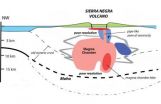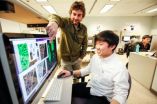(Press-News.org) The Galápagos Islands are home to some of the most active volcanoes in the world, with more than 50 eruptions in the last 200 years. Yet until recently, scientists knew far more about the history of finches, tortoises, and iguanas than of the volcanoes on which these unusual fauna had evolved.
Now research out of the University of Rochester is providing a better picture of the subterranean plumbing system that feeds the Galápagos volcanoes, as well as a major difference with another Pacific Island chain—the Hawaiian Islands. The findings have been published in the Journal of Geophysical Research: Solid Earth.
"With a better understanding of what's beneath the volcanoes, we'll now be able to more accurately measure underground activity," said Cynthia Ebinger, a professor of earth and environmental sciences. "That should help us better anticipate earthquakes and eruptions, and mitigate the hazards associated with them."
Ebinger's team, which included Mario Ruiz from the Instituto Geofisico Escuela Politecnica Nacional in Quito, Ecuador, buried 15 seismometers around Sierra Negra, the largest and most active volcano in the Galápagos. The equipment was used to measure the velocity and direction of different sound waves generated by earthquakes as they traveled under Sierra Negra. Since the behavior of the waves varies according to the temperature and types of material they're passing through, the data collected allowed the researchers to construct a 3D image of the plumbing system beneath the volcano, using a technique similar to a CAT-scan.
Five kilometers down is the beginning of a large magma chamber lying partially within old oceanic crust that had been buried by more than 8 km of eruptive rock layers. And the oceanic crust has what appears to be a thick underplating of rock formed when magma that was working its way toward the surface became trapped under the crust and cooled—very much like the processes that occur under the Hawaiian Islands.
The researchers found that the Galápagos had something else in common with the Hawaiian Islands. Their data suggest the presence of a large chamber filled with crystal-mush magma—cooled magma that includes crystallized minerals.
The Galápagos Islands formed from a hotspot of magma located in an oceanic plate—called Nazca—about 600 miles of Ecuador, in a process very similar to how the Hawaiian Islands were created. Magma rising from the hotspot eventually hardened into an island. Then, as the Nazca plate inched its way westward, new islands formed in the same manner, resulting in the present-day Galápagos Archipelago.
While there are several similarities between the two island chains, Ebinger uncovered a major difference. The older volcanos in the Hawaiian Islands are dormant, because they've moved away from the hotspot that provided the source of magma. In the Galápagos, the volcanoes are connected to the same plumbing system. By studying satellite views of the volcanoes, Ebinger and colleagues noticed that, as the magma would sink in one, it would rise in a different volcano—indicating that that some of the youngest volcanoes had magma connections, even if those connections were temporary.
"Not only do we have a better understanding of the physical properties of Sierra Negra," said Ebinger, "we have increased out knowledge of island volcano systems, in general."
The Galápagos Islands are home to some of the most active volcanoes in the world, with more than 50 eruptions in the last 200 years. Yet until recently, scientists knew far more about the history of finches, tortoises, and iguanas than of the volcanoes on which these unusual fauna had evolved.
Now research out of the University of Rochester is providing a better picture of the subterranean plumbing system that feeds the Galápagos volcanoes, as well as a major difference with another Pacific Island chain—the Hawaiian Islands.
INFORMATION: END
First-ever 3-D image created of the structure beneath Sierra Negra volcano
2014-03-06
ELSE PRESS RELEASES FROM THIS DATE:
Sickle cell trait: Neglected opportunities in the era of genomic medicine
2014-03-06
(Boston)--While acknowledging the potential of genomics to prevent and treat disease, researchers from Boston Medical Center (BMC) and Boston University School of Medicine (BUSM) believe it is long past due to use current scientific data and technical advances to reduce the burden of sickle cell disease (SCD), one of the most common serious single gene disorders. The work, reported as a Viewpoint in this week's Journal of the American Medical Association (JAMA), highlights the gaps in knowledge and care in terms of SCD and the need to address this issue expeditiously. ...
Physician bias does not affect hypertension treatment for minority patients, says CU
2014-03-06
Doctors' unconscious biases favor whites but do not affect high blood pressure treatment for their minority patients, according to a University of Colorado Boulder study, even though a previous study by the same research group found that doctors' biases are reflected in lower ratings by African-American patients.
The new research, led by Irene Blair, an associate professor in CU-Boulder's Department of Psychology and Neuroscience, is published in the Journal of General Internal Medicine.
"We know that minorities have to face bias and discrimination in many different ...
Astronomers witness mysterious, never-before-seen disintegration of asteroid
2014-03-06
Astronomers have witnessed for the first time the breakup of an asteroid into as many as 10 smaller pieces. The discovery is published online March 6 in Astrophysical Journal Letters.
Though fragile comet nuclei have been seen falling apart as they near the sun, nothing resembling this type of breakup has been observed before in the asteroid belt. NASA's Hubble Space Telescope photographed the demolition.
"Seeing this rock fall apart before our eyes is pretty amazing," said David Jewitt, a professor in the UCLA Department of Earth, Planetary and Space Sciences ...
Hubble witnesses an asteroid mysteriously disintegrating
2014-03-06
The NASA/ESA Hubble Space Telescope has photographed the never-before-seen break-up of an asteroid, which has fragmented into as many as ten smaller pieces. Although fragile comet nuclei have been seen to fall apart as they approach the Sun, nothing like the breakup of this asteroid, P/2013 R3, has ever been observed before in the asteroid belt.
"This is a rock. Seeing it fall apart before our eyes is pretty amazing," said David Jewitt of UCLA, USA, who led the astronomical forensics investigation.
The crumbling asteroid, designated P/2013 R3, was first noticed as an ...
Transplanted human umbilical cord blood cells improved heart function in rat model of MI
2014-03-06
Putnam Valley, NY. (Mar. 6, 2014) – When human umbilical cord blood cells were transplanted into rats that had undergone a simulated myocardial infarction (MI), researchers investigating the long term effects of the transplantation found that left ventricular (LV) heart function in the treated rats was improved over those that did not get the stem cells. The animals were maintained without immunosuppressive therapy.
The study will be published in a future issue of Cell Transplantation but is currently freely available on-line as an unedited early e-pub at: http://www.ingentaconnect.com/content/cog/ct/pre-prints/content-ct0860Chen.
"Myocardial ...
Misplaced protein causes heart failure
2014-03-06
Colchicine, a drug that's used to treat gout, has the beneficial side effect of lowering the risk of heart attack in patients taking it. Conversely, taxol, a drug for treating cancer, has the opposite effect; raising the risk of heart failure.
What both these drugs have in common is that they act on microtubules – a network of fibers inside heart cells that provide internal structural support. Previous studies, including evidence from human patients and experimental models of heart failure, have suggested a link between heart failure and increased density of microtubules, ...
IUPUI researchers use computers to 'see' neurons to better understand brain function
2014-03-06
INDIANAPOLIS— A study conducted by local high school students and faculty from the Department of Computer and Information Science in the School of Science at Indiana University-Purdue University Indianapolis reveals new information about the motor circuits of the brain that may one day help those developing therapies to treat conditions such as stroke, schizophrenia, spinal cord injury or Alzheimer's disease.
"MRI and CAT scans of the human brain can tell us many things about the structure of this most complicated of organs, formed of trillions of neurons and the synapses ...
Complications following surgery predict costly readmissions
2014-03-06
The presence – or absence – of complications following surgery is a strong indicator of which patients are likely to be readmitted to the hospital in the 30 days following their procedure, according to a study published today in JAMA Surgery. Predicting which patients are most likely to experience complications using a simple online tool may allow healthcare professionals to flag patients at high risk of readmission in real time and alter care to reduce expensive trips back to the hospital.
The study examined more than 142,000 patients who had non-cardiac surgery using ...
Listening to whispers at the water cooler
2014-03-06
Just as she was about to retire, Lily Ledbetter, a production supervisor at an Alabama tire plant, learned that her employers had financially discriminated against her throughout her career. She filed suit for pay discrimination, losing due to a statute of limitations on equal-pay suits. As a result, President Barack Obama signed the Lily Ledbetter Fair Pay Act into law in 2009, drawing attention to the effects of pay secrecy on the workplace.
Now Prof. Peter Bamberger of Tel Aviv University's Recanati School of Business and Dr. Elena Belogolovsky of Cornell University's ...
Strong teams attract crowds for international cricket
2014-03-06
The strength of the team — not the promise of a close contest — is the biggest draw to crowds in international cricket, new research has found.
The findings from the study, published in the journal Applied Economics, appear to contradict previous research which suggested that attendance is largely determined by how closely matched the two teams are during a game.
Economists Dr Abhinav Sacheti and Professor David Paton from Nottingham University Business School, in collaboration with Dr Ian Gregory-Smith from the University of Sheffield, analysed the number of spectators ...





